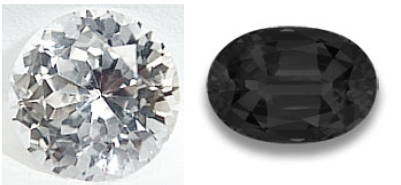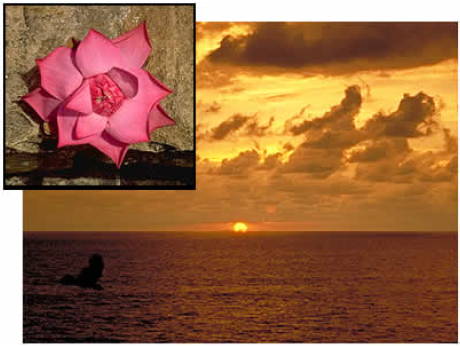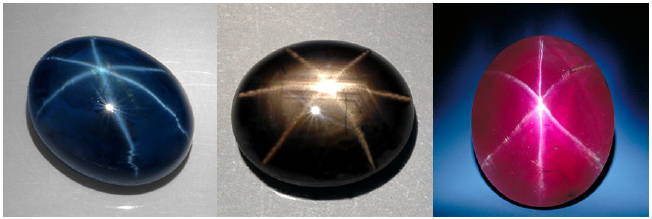Colors: All colors
Durability: Tough
Refractive index: 1.76-1.78
Treatment: Assume heating, (rarely surface diffusion for sapphires, oiling for low-quality rubies)
Hardness: 9
Availability: Fine rubies up to five carats; sapphires up to ten carats
Localities: Ruby: Myanmar (Burma), Thailand, Africa, Vietnam Sapphire: Myanmar, Thailand, Australia, Sri Lanka, Montana, Tanzania, Madagascar

Rubies and sapphires are the same minerals: corundum, with different trace minerals that give either shade of red or blue.
Rubies and sapphires have been treasured for thousands of years.
They were named long before anyone realized they were actually the same mineral.

Pure corundum is rare in nature and is perfectly colorless.
Small amounts of metallic elements can substitute for aluminum in the corundum crystal structure, giving rise to many color variations.
Gem corundum of any color is referred to as sapphire with a preceding color designation if the color is any other than blue.
Blue corundum is called sapphire.
There are two different color varieties of corundum with specific names; the pinkish-red to red ruby and the orangish-pink padparadscha.

The famous pinkish-red to red ruby owes its color to chromium impurities, and the color of the rare orangish-pink padparadscha sapphire is from both iron and chromium impurities.
The color of the well known blue sapphire (or only sapphire) is due to iron and titanium.
Iron also can cause the color in some yellow sapphires, while other yellow sapphires owe their color to irradiation-induced ‘color centers.’

Iron also can cause the color in some yellow sapphires, while other yellow sapphires owe their color to irradiation-induced ‘color centers.’
Different colors influencing sapphires are vanadium, cobalt, and nickel.
In some cases, the color and the clarity in gem corundum can be modified by a number of processes in common use today.

Most of these processes involve heating, often in the presence of specific chemical ingredients, to intensify a natural color or sometimes to induce an entirely different color altogether.
Many light gray to pale blue gem corundums with a ‘silky’ look due to microscopic titanium oxide inclusions are heated to near their melting point, resulting in the dissolution of the silk-causing inclusions producing a more transparent gem.
This improvement in clarity is often accompanied by a much stronger deep blue color as well.

Gem corundum that exhibits natural color and clarity commands a significant price over comparable artificially enhanced corundum of natural origin.
Determining whether natural gem corundum has been artificially enhanced can be very difficult and is quite often impossible with the naked eye alone.
Special techniques and equipment are usually necessary, and even then, some doubts can remain.
Corundums are truly amazing crystals as some of them can exhibit more than one color (Dichroic sapphire on the left) and even totally change color (in the same way as some alexandrite do) by being exposed to different light sources (color change sapphire on the right).

A quite sensible subject is the definition of the colors of rubies and padparadscha sapphires.
This subject is vital since it can shift the value of stones hundreds, even thousands of dollars up or down for these gems.
As you will see, the line between mere pink sapphires and the padparadschas and rubies can sometimes be extremely thin…

Some have described the ideal color of a padparadscha as the marriage between a Sri Lankan lotus flower and a sunset, as shown above.
Where is the line defining if a gem is a pink or orange sapphire or the extremely expensive but exquisite and beautiful padparadscha?

All the gems above as been labeled as padparadscha……???
Determining if corundum is on the rubies or pink sapphire’s side can be quite hazardous.
Even with precise, certified color chart references, the final decision can always be tainted by the professional’s subjectivity.

Here are four corundums of the same hue (red), but showing a variation in saturation and tone.
Most gem dealers would classify stones 3 and 4 as rubies, while stone 1 would be a pink sapphire.
Stone 2 walks the line, a ruby to some, while a mere pink sapphire to others.
This clearly illustrates the problems created by an overly narrow variety of definitions.
This gives you just a sample of the head hacks the certified gemologists can experience when trying to draw the very thin line between rubies, padparadschas, and pink sapphires.

Some corundum occurs with minute rutile inclusions oriented at an angle of 120 degrees from each other according to the corundum’s hexagonal symmetry.
If the concentration of rutile fibers is sufficiently dense, then when this material is fashioned into a cabochon gem with the C axis of the corundum perpendicular to the base of the stone, reflected light from the rutile inclusions could concentrate on the surface of the gem forming white lines that intersect every 60 degrees forming a six ray star.


This material is known as star ruby if it is pinkish-red to red, or as star sapphire with a color prefix for all other colors other than blue.
Blue star corundum is called star sapphire.
Most synthetically produced star corundum has perfect stars with fine, straight rays.
Natural star corundum characteristically has some imperfections, although occasionally natural star corundum does occur with an exceptionally fine quality near-perfect star.
A perfect star ruby or star sapphire should have the following features:
1- The star should be centered.
2-The legs of the star should be sharp and well defined and not blurred.
3-The star should be silvery or milky white.
4-The length of the rays should extend up to the base of the stone.
5-The stone must be translucent.
6-The stone should have a desirable body color: intense pure blue for star sapphires, pigeon-blood color for star rubies, but pinkish red colors are also valued.
